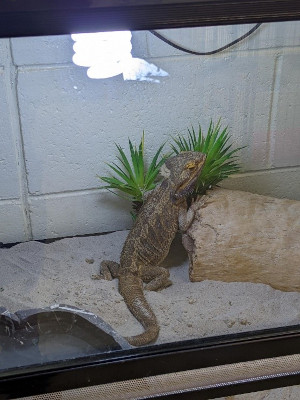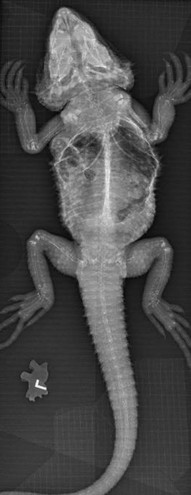Why does my reptile need sunlight?

It is commonly said that pet reptiles should get a few hours (at least) outside in the sun. Artificial lighting is also used indoors, trying to replicate sunlight. But why do reptile keepers go to such lengths?
Sunlight contains so-called white light (light that contains all the wavelengths of visible light at approximately equal intensities), as well as ultraviolet light. Both are important to the health of your reptile.
White light
Both the quality and quantity of light have important consequences for the health of captive reptiles. Annual cycles of day length may affect appetite, metabolism, and perhaps reproduction. (Environmental temperature, rather than light, appears to be the more influential factor affecting reproduction in reptiles.) Light activates a gland in the reptile brain which, in turn, stimulates the production of the hormone melatonin. In subdued light, most probably as a result of insufficient stimulation of this organ, many species of reptiles do not exhibit their normal regulation of temperature and their normal patterns of activity.
Little is known about the optimal light intensities, their gradual variations during the day, and their influence on normal, optimal behaviour of reptiles. However, there are sufficient indications that variation in light intensity causes reactions in reptiles that affect growth, development, and colour of some species of reptile.
In captivity, lights are often either on or off, compared to the dimmer lighting at dawn and dusk provided by natural light. By allowing sunlight into the room, without the heating aspect, the lighting can gradually decrease/increase, and then the lights come on/off via a timer. To obtain a more natural situation, some compensation can be achieved by allowing daylight to enter the terrarium – the natural lighting gradually decreases at dusk and increases at dawn, and in addition to the terrarium lights which turn on/off via a timer. In this way, for instance, the annual sexual cycles of reptiles can be influenced. Another possibility is to synchronise the time that the terrarium lights are programmed to be on to mimic the seasonal variations in daylight (i.e., on for longer during the summer when the hours of sunlight are naturally greater than in winter). The discovery that that the variation in light intensity and duration that occurs across the different seasons influences reptiles’ reproductive cycles was a major contribution to the successes achieved in breeding reptiles.
Unlike their mammalian counterparts, nocturnal snakes (active at night) have small eyes compared with diurnal snakes (active by day). Nocturnal snakes rely upon a combination of scent, heat, and vision. Geckos, on the other hand, have large eyes due to their sole reliance on vision.
Most snakes and lizards have well-developed vision as well as a chemosensory system (a combination of the smell and taste working through the vomeronasal system in the roof of the mouth).
Taken altogether, it is wise to have a lighting system for your reptile enclosure that allows a normal day-night cycle. As many reptiles are sensitive to the flickering of some fluorescent tubes, it may be best to use bulbs for white light, rather than tubes.
Ultraviolet light
UV (ultraviolet) light is part of the electromagnetic spectrum of light. It is a wavelength that can’t be seen by the human eye, although it is visible to many animals including reptiles. UV light is divided into three spectrums:
- UVA is the wavelength that contributes to the emotional and behavioural wellbeing of reptiles. Social behaviours, activity levels, feeding, and reproduction are all increased in lizards exposed to adequate UVA. UVA is found in natural lighting (sunlight), full spectrum artificial lighting, and good quality UV lights.
- UVB triggers a chemical reaction in the skin that results in the production of vitamin D3, necessary for the absorption of calcium from the gastrointestinal tract. Without vitamin D3, calcium cannot be absorbed, no matter how much is added to the diet. UVB is filtered out almost completely by glass and plastic, and so sunlight through a closed window or the side of an enclosure is not enough. Many UVB lights produce adequate levels of UVB, but the amount is variable and without a UVB meter it is difficult to say if a light is working properly. Unfiltered sunlight for 2-4 hours a week is more effective, and it is free!
- UVC is toxic and carcinogenic. Fortunately, it is filtered almost completely by the ozone layer. Most artificial lights do not emit UVC.
Reptiles (except perhaps snakes) who are deprived of exposure to UVB cannot absorb calcium from their diet, resulting in metabolic bone disease i.e., their body takes calcium out of their bones to use it elsewhere – the result is thin, weak bones that are painful to walk on and often break under their own weight. Other harmful effects arising from the lack of adequate UVB and UVA exposure stem from the negative impact this lack has on the immune system. Without a functional immune system, diseases such as pneumonia, gut stasis, egg binding, and bacterial septicaemias become more common.

Bearded dragon with metabolic bone disease – note how thin the bones are and, in places, almost missing.
From the above, we can see that reptiles need both white light and UV light. The best place to get this is from is the sun, but artificial lights are often capable of replicating the effect of sunlight for reptiles housed indoors.
Bibliography
RSPCA Australia believes that captive-bred wild animals should not be kept in a home environment or for companion purposes unless the species has been clearly identified as being suitable for this purpose. It is important that animals living in a home environment can live a good life. This means providing for their physical health and ensuring opportunities to fully express their individual interests and experience good welfare. Inadequate care and husbandry are reported to contribute to common and serious welfare compromises in many captive wild animals living in home environments. For more information see our policy.
The reality is, however, that captive-bred wild animals are kept in home environments despite sometimes not meeting these criteria (e.g., some reptile and bird species). Because of this, the RSPCA has produced these articles on the care and welfare of a variety of commonly kept captive-bred wild animals. The aim is to help people better understand their animals as individuals and provide them with care that keeps them healthy and provides opportunities for positive mental experiences as much as possible in captivity.
Wild animals must not be taken from the wild to be kept as companion animals (pets).
Was this article helpful?
This work is licensed under a Creative Commons Attribution-NonCommercial-NoDerivatives 4.0 International License.



